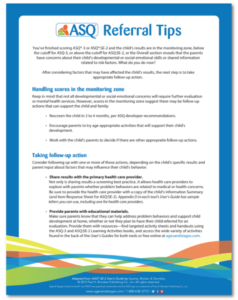Success After Screening
Best practices for better follow-up

“When parents complete the ASQ®, it’s like checking a child’s temperature,” explains Kimberly Murphy, a research assistant at the University of Oregon. Ms. Murphy coordinates several studies for the authors of ASQ®-3 and ASQ®:SE-2 and speaks often with parents.

She likens the ASQ to a thermometer, often the gauge that pushes a parent to seek medical consultation or not. “The screening is a first step that tells parents whether their child’s development is taking place on schedule for that age, or if it’s time to investigate further and seek professional help.”
That’s the point when parents depend on experts like you—to provide best-practice-based guidance on the next step, whether it be a referral or another follow-up approach.
Step 1: Determine the type of follow-up needed
After scoring a child’s ASQ-3 or ASQ:SE-2 questionnaire and reviewing parent responses to the Overall section, it’s time to interpret the Information Summary sheet to determine whether the scores in each area are above, below, or close to the cutoff. The following general cutoff criteria and Overall section guidance give a framework for making referral decisions, but should be considered along with other factors, as well as your program’s established referral processes. Additional detail can be found in Chapter 6 of the ASQ-3 User’s Guide and Chapter 4 of the ASQ:SE-2 User’s Guide.
Cutoff criteria for the ASQ-3
Scores well above the cutoff: These kids are considered to be “typically developing” or “on schedule” and require no further assessment, if the parents have no concerns. Even if there are no concerns, questionnaire results should always be shared and reviewed with parents. You may opt to rescreen at 4- to 6-month intervals and recommend appropriate developmental activities, depending on the situation and parent concerns. You can also complete an ASQ:SE-2 screening if there are any social-emotional concerns.
Scores close to the cutoff: This is the “monitoring zone.” When results are close to the cutoff, it is important to review items and parent responses in the Overall section to determine a final result. Parents may need help completing items, or items may have been omitted. Parent concerns indicate a need for additional support or guidance. You may want to rescreen at a shorter set interval (e.g., 1–2 months) or even refer if several of the child’s scores are in the lower end of this gray area, close to the cutoff. In all cases, suggest that parents engage in developmental learning activities that target the area(s) of concern.
Scores below the cutoff: Scores on or below the cutoff in one or more areas indicate a need for further assessment. The questionnaire review with the child’s parents should include information about referral options. Before making a referral, it is important to consider whether factors, such as health and biological factors, behavioral concerns, cultural factors, or environmental factors, affected the results.
Cutoff Criteria for the ASQ:SE-2
Scores above the cutoff: The reverse of ASQ-3, scores above the cutoff in ASQ:SE-2 indicate a concern for social-emotional development. Review the ASQ:SE-2 together with parents and discuss any concerns that they have. You may refer for diagnostic social-emotional or mental health assessment or provide parents with information and support and monitor the child through rescreening.
Scores close to the cutoff: These scores may indicate a potential concern for social-emotional development. Review the ASQ:SE-2 together with parents and discuss any concerns that they have. Your program may want to designate your own “questionable” range and account for any substantial parental concerns. Possible actions may include referring for diagnostic social-emotional assessment or providing information, support, and continued monitoring. In all cases, suggest that parents engage in developmental learning activities that target the social-emotional area(s) of concern.
Scores below the cutoff: These scores indicate that social-emotional development is on schedule. Review the ASQ:SE-2 together with parents and provide parents information and support if they need it. You may opt to rescreen in 4 to 6 months, or at recommended intervals. If you or a parent still has concerns about social-emotional development, discuss those with the parents and determine if a rescreening should be completed sooner.
What are some best practices for determining follow-up?
Regardless of which screening tool you use, here are a few basic best practices that will help you make confident follow-up decisions. Of course, these are to be considered along with the recommended cutoff and referral criteria.
- Look at the big picture. ASQ results are not complete until scores have been reviewed together with parents, including the Overall responses and any other concerns. Results are never “black and white”, and conversations with parents are key to building a complete picture. It’s important to understand how the environment, development, health, and family/cultural factors may have influenced a child’s score. Big-picture consideration is very helpful when scores are near a cutoff point. And remember, parents take the lead in follow-up decisions.
- Address all parent concerns. If a parent reports a concern during conversation or on the questionnaire—even if it isn’t reflected in the scores—take appropriate follow-up action, whether it be providing information or a referral. For guidance, see Table 6.3 from the ASQ-3 User’s Guide or pages 93–103 in the ASQ:SE-2 User’s Guide.
- Screen and rescreen. If a child is near a cutoff area, or you suspect outside factors affected a child’s score, rescreen in a few months to look for growth or changes before referring.
- Use your professional judgment. If screening results do not validate your concerns, seek out alternative ways to identify delays and provide services. It’s important to investigate any factors that may have led a parent to interpret their child’s behavior or development differently. This provides an opportunity for parents and providers to learn more about a child’s or family’s needs.
Step 2: Sharing Results with Parents
When discussing with parents a subject as delicate as their child’s developmental or social-emotional health, it’s best to be positive and strategic. And, it’s important to remember that all scores, whether of concern or not, should be reviewed with parents.
“An ASQ-3 or ASQ:SE-2 result is not valid until the provider has reviewed the completed questionnaire with the parent, including the Overall responses,” says Liz Twombly, M.S., co-developer of the ASQ:SE-2.
During every family discussion, even if the child’s scores don’t indicate a potential concern, it’s important to ask parents about their own concerns. What have they or others noticed and what have they done about it? This can identify concerns that may not have been reflected in the scores, and it allows for an on-going conversation about development and expectations to occur between parents and providers.
“Be sure that all guidance is positive, instructive, and proactive” says Murphy. “Conversations with families should also address cultural differences or factors that may influence item responses or concerns, and whether Learning Activities/intervention activities are or are not culturally appropriate.”
What are some best practices for sharing results with parents?
Below are some additional tips that can be helpful across the board when discussing results:
- Share results in person, by phone, or in writing (paper or email) in a family-friendly tone.
- Highlight child strengths first and then any areas of concern.
- Provide parents with activities that are appropriate for the family’s culture to support their child’s needs and interests.
- Tell them when another screen will be administered.
- Review the purpose of screening.
- Expect questions even with typical results.
- Make sure the conversation is aimed at relationship-building. Help parents feel they are part of the child’s team.
Best Practices in Action
Take a peek at the Florida Office of Early Learning’s developmental screening process, and learn from their tried-and-true best practices.
When we read advice on how to talk to parents about screening results, it’s easy to assume it mostly applies to children whose scores indicate a need for further monitoring or assessment. “That’s a big concern of mine,” says Ms. Murphy, “It’s important to remember that most parents—especially the ones who sought out screening on their own—are concerned about their children’s development. All families should be spoken to the same way, with interest, empathy and positivity.”
Step 3: Initiating the Referral Process
When a child’s ASQ-3 or ASQ:SE-2 scores suggest the need for further assessment or intervention, program personnel should prepare in advance for the family discussion and conduct it with compassion and empathy. In these cases, results and next steps should always be discussed in person or over the phone—never via mail or email—and in a private, confidential setting. The ASQ Referral Tips handout provides a number of tips and strategies for providers navigating the referral process.

While there are certainly best practices for discussing referrals, be sure that the parents are truly informing and directing the process. With your professional guidance, parents should decide what and when specific follow-up actions should be taken. Then you should adjust the type of assistance offered based on the family’s unique resources and needs. If parents are resistant to referral at first, be flexible and provide them with options. It’s unlikely to be welcome news for parents, and some may downplay the concerns, so offering a few different options or ideas can improve the chances of the parents following through on the referral.
You can also help ease their minds by providing more than just a referral. Recommend some learning activities they can do at home, let them know you will rescreen in a few months to monitor, and/or give them additional information by way of articles or pamphlets.
“A lot of blogs and websites people find on their search for more info are written in ways that emphasize concerns, and the information may not be the most accurate or may not provide the appropriate context, such as a reference to the range of age in which a behavior is expected to appear,” says Ms. Murphy. “Participants in the online ASQ studies are offered resources from non-profit sites with information that is researched and written by professionals in a positive, educational tone specifically for parents.”
What are some best practices for referring a child for further assessment?
The ASQ user’s guides have a lot of guidance on how to work through the referral process. Below are a number of additional tips for establishing trust and strengthening communication with parents:
- Consider any cultural differences that may determine who should be included in the conversation.
- Find a private setting to talk with parents confidentially.
- Ask family about their concerns about their child.
- Review results using terms related to cutoff scores.
- Discuss influencing factors such as health, language, environment, or cultural differences that may change the way a parent has responded to some items.
- Explain that screening does not assess or diagnose their child.
- Provide specific, non-judgmental examples of the concerns noted.
- Emphasize parents’ skills and resources to work with their child.
- Provide information about referral services and options.
- Determine if parents will contact the referral or if they prefer you take the initiative.
To ensure you can easily make an appropriate and timely referral, keep your resources list up to date with agencies and programs that provide developmental assessments and intervention services to infants and young children. Include for each entry:
- agency/program name and address
- contact person
- phone number
- eligibility criteria for assessment and/or intervention
- services provided
The next steps you take after ASQ screening can have a profound impact on both short- and long-term child outcomes. Use the practical tips in this article as a helpful guide during your post-screening process. And for more on determining follow-up steps, sharing results with parents, and navigating referrals successfully, turn to the helpful information in the user’s guides for ASQ-3 and ASQ:SE-2.
(Originally published April 2014; Updated July 2022)
If you found this article helpful, you may enjoy our ASQ newsletter. Sign up to receive the monthly newsletter.


